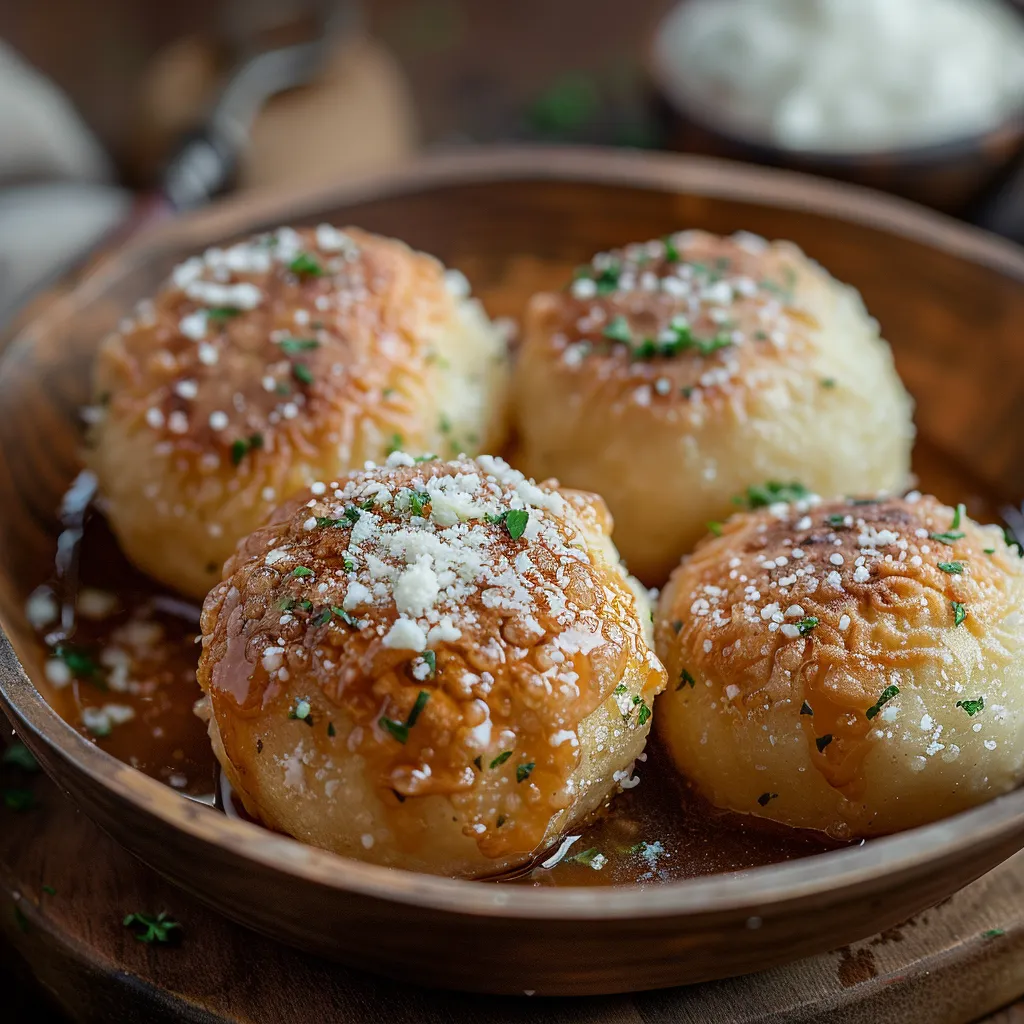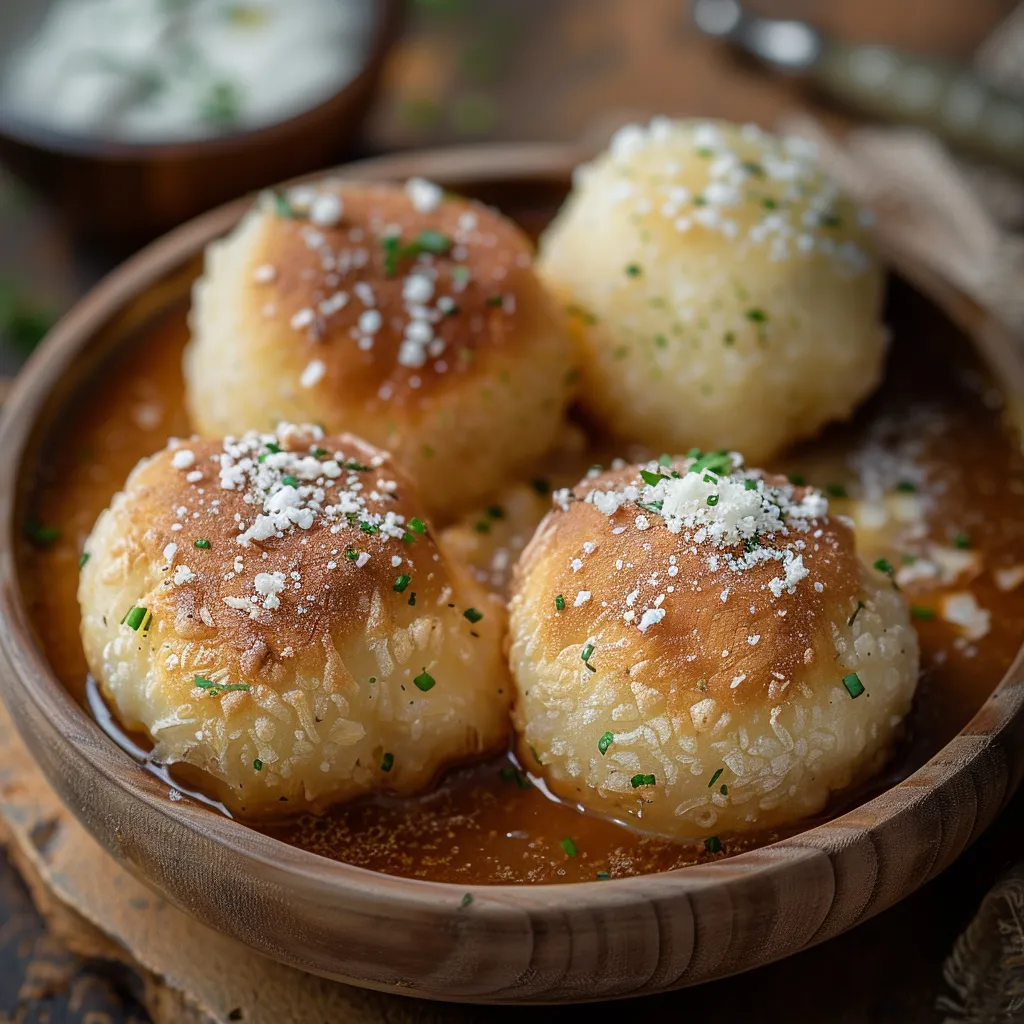 Pin it
Pin it
This rustic Semmelknödel recipe brings authentic German bread dumplings straight to your table with simple ingredients and traditional techniques. These pillowy dumplings transform day-old bread into a comforting side dish that pairs beautifully with roasted meats, stews, or simply pan-fried in butter for a delicious meal on their own.
I first learned to make these dumplings from my Austrian neighbor who insisted proper Semmelknödel were the secret to any good Sunday roast. After years of perfecting my technique, these dumplings have become my signature contribution to family gatherings.
Ingredients
- Day-old bread rolls or soft pretzels: The dryness helps absorb the milk without becoming mushy. Authentic German brötchen work best, but any crusty rolls will do.
- Milk: Creates the soft, tender texture. Whole milk yields the richest results.
- Butter: Use unsalted European-style butter for authentic flavor.
- Onion: Adds savory depth when slowly cooked until golden.
- Fresh parsley: Provides color and bright flavor contrast.
- Eggs: Act as binding agents to hold the dumplings together.
- Crispy bacon bits: Optional but adds wonderful smoky notes.
- Nutmeg: Just a touch enhances the warmth without dominating.
- Salt and pepper: Essential for properly seasoned dumplings.
- Fine breadcrumbs: Helps adjust consistency if your mixture is too wet.
Step-by-Step Instructions
- Prepare the Bread:
- Cut bread rolls into uniform cubes about half to three-quarter inch in size. Place in a large bowl. Keep the crust intact as it adds texture and helps hold the dumplings together.
- Create the Milk Soak:
- Heat milk until very warm but not boiling. Pour over bread cubes and press down with a spoon to ensure even soaking. Allow to rest for 15 minutes until bread has softened and absorbed most of the liquid.
- Sauté the Aromatics:
- Dice onion finely and cook in melted butter over medium heat for 8-10 minutes. The onions should become translucent and golden but not browned. This slow cooking develops sweetness and removes harsh raw onion flavor.
- Combine Ingredients:
- Add sautéed onions to soaked bread mixture. Incorporate chopped parsley, beaten eggs, crumbled bacon if using, nutmeg, salt, and pepper. Add two tablespoons of fine breadcrumbs to help bind everything.
- Form the Mixture:
- Knead thoroughly with your hands until completely combined. The texture should be slightly sticky but hold together. If too wet, add more breadcrumbs. If too dry, add a splash more milk. The consistency is crucial for proper dumplings.
- Shape the Dumplings:
- Form tennis ball-sized dumplings with wet hands to prevent sticking. Press firmly to compact each dumpling, ensuring they hold together during cooking. You should yield approximately 12 dumplings.
- Cook Gently:
- Bring a large pot of salted water to just below simmering point. The water should show tiny bubbles but never boil vigorously. Cook dumplings in batches of four for 20 minutes. Start with a test dumpling to ensure proper consistency.
- Serve or Crisp:
- Enjoy dumplings as is or slice and pan-fry in butter until golden and crispy on both sides. The crispy version develops delicious contrasting textures.
 Pin it
Pin it
My grandmother always insisted that Semmelknödel demanded the lightest touch when mixing. She would say that heavy hands make heavy dumplings and would gently press rather than aggressively knead the mixture. That attention to detail is what makes these dumplings special.
Storage and Make-Ahead Tips
These dumplings store remarkably well. After cooking, cool completely and refrigerate for up to three days. To reheat, either simmer gently in broth for 5 minutes or slice and pan-fry in butter. For longer storage, place cooled dumplings on a baking sheet, freeze until solid, then transfer to freezer bags. They'll keep for up to three months. Reheat from frozen by simmering in broth for 10 minutes.
Traditional Serving Suggestions
In Bavaria and Austria, Semmelknödel typically accompany rich meat dishes with plenty of gravy. They're perfect alongside sauerbraten, goulash, or classic German rouladen. For a complete meal, serve with roasted meats and braised red cabbage or sauerkraut. Vegetarians can enjoy them with creamy mushroom sauce or simply pan-fried until crispy with a fresh green salad.
Regional Variations
Across German-speaking regions, you'll find subtle differences in preparation. Tyrolean versions often include speck instead of bacon. In parts of Bavaria, they add chopped liver for richness. Some regions shape the mixture into a log and slice after cooking rather than forming individual dumplings. In Czech cuisine, the similar knedlíky are often made with flour rather than bread. Each variation reflects local tastes and available ingredients.
 Pin it
Pin it
Frequently Asked Questions
- → Can I use fresh bread to make Semmelknödel?
It's best to use day-old or slightly stale bread for the perfect texture. Fresh bread can make the mixture too moist and difficult to shape.
- → How do I prevent the dumplings from falling apart during cooking?
Ensure the mixture is sticky but firm. Test-cook one dumpling first and make necessary adjustments by adding breadcrumbs or milk.
- → Can I make Semmelknödel ahead of time?
Yes, you can prepare and shape the dumplings in advance. Refrigerate them for a few hours before cooking or freeze for later use.
- → What can I serve with Semmelknödel?
Semmelknödel pairs well with rich gravies, roasted meats, or creamy mushroom sauces. You can also enjoy them pan-fried as a side dish.
- → Can I customize the ingredients?
Absolutely! You can add ingredients like crumbled bacon, cheese, or different herbs to give the dumplings a personalized flavor.
